It’s funny when I think of how many aspects of today’s world I use and enjoy yet have no idea how they work.
People drink coffee everyday, but don’t give much thought of the long process from seed to cup.
It’s easy to take for granted what we don’t understand, but sometimes “seeing how the sausage is made” broadens the perspective of the things we love.
And what is one thing the world universally loves so dearly? Coffee!
Okay, that might have been a bit anticlimactic, but for some folks this stuff is the real deal. Battles have been fought over it! With over 400 billion cups of coffee sold per year worldwide, and over 450 million cups consumed in the states alone, the industry has never been so monstrous.
With how much we seem to worship this precious coffee bean, most of us are none the wiser about its creation and cultivation.
Today, that changes. You might even consider growing a coffee plant!
How Are Coffee Beans Grown?
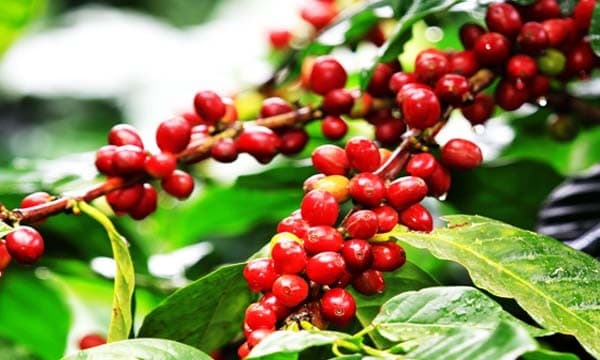
Well, for starters, they come from a tree!
Coffee beans aren’t actually beans. Instead, they’re pits from the fruit (the cherries), which grows on the trees they’re harvested from. They’re essentially seeds. If the “seeds” aren’t processed or roasted, they can be planted to produce more coffee trees.
The flowers fully mature and produce cherries around 7 to 9 months after the initial bloom.
There are dozens of different species variations, but the two main genera are Arabica and Robusta.
These trees (or Evergreen shrubs) grow between 15 and 20 feet tall and thrive in humid and moist climates. One of many reasons why South America is perfect for coffee farming.
Arabica trees are notorious for being difficult to manage but offer a higher quality coffee bean. They make up over 70 percent of the world’s coffee. Due to their difficult cultivation and how easily they fall prey to disease, they’re usually more expensive.
Robusta is slightly lower in quality but makes up for it in sheer durability. This robust shrub has been known to grow up to 10 meters (32 feet). They are far easier to farm than Arabica shrubs and require less care. They hold about 2x more caffeine which gives them a bitter bite. Their resistance to disease and pests truly earns the title “robust.”
Coffee shrubs can be challenging to take care of and grow. They require sunlight, but direct light will harm them. They use more water than typical trees. The soil must always be moist, which is why planting is done in the rainy seasons.
Make sure to check out our related article, A Guide To Choosing The Right Coffee Blend For You.
Where Is Coffee Grown?
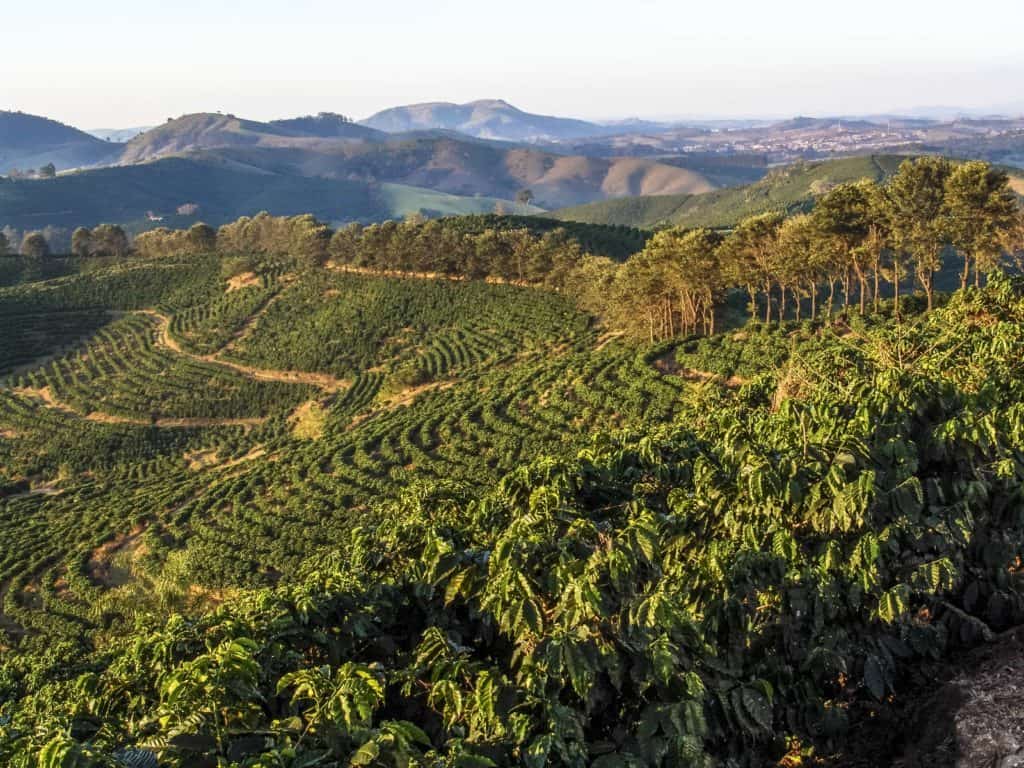
I love and adore this precious beverage, but we do not share the same preference of accommodation. Coffee trees love tropical climates that receive lots of rain (about 1500 to 3000 mm annually), which means hot and muggy.
These countries make up the “coffee belt,” which spans along the north and south sides of the equator through South America, Central America, Southeast Asia, and parts of Indonesia.
Coffee originally hails from Ethiopia after it was discovered in the cherries of certain blossoms in the 11th century. These cherries were boiled down, exhibiting people the effects of coffee. It actually used to be ground into a paste-like texture and chewed.
This Magic fruit swiftly spread to the rest of the world as trading ports became more established.
South America
Today, large portions of coffee come out of South America, primarily Brazil.
Brazil is the world’s number one coffee producer, accounting for 40 percent of all coffee worldwide!
Initially brought over by French explorers in the early 18th century, the landscape was perfect for this wonder crop that was already a sweeping sensation throughout western Europe. Its tropical and mountainous terrain is ideal, and today roughly 300,000 coffee farms exist throughout the countryside.
A more famous South American coffee country is Columbia. Whether you’re a coffee drinker or not, you’ve heard of Columbian Roast Coffee before.
Columbia is notorious for growing high-quality coffee beans. They’re the second biggest exporter of Arabica coffee. In the mid-2000s, their crops experienced an epidemic of a disease called “leaf rust,” which postponed their operations which they have since recovered, maintaining a position on the mantle.
Southeast Asia

Other parts of the world, like Southeast Asia, have been inching up the totem pole. Vietnam has become the second-largest exporter of coffee in recent years.
Enormous investments made on coffee in the 1980s successfully caused a massive economic boom. In the 1990s, production spiked 30 percent every year over the entire decade. The luscious landscape was perfectly suitable for the plant. They focused on growing Robusta shrubs, which provided them with a niche product with larger, more frequent yields.
Vietnam is the number one exporter of Robusta coffee beans, contributing 40 percent to global trade. Overall, they produce 20 percent of the world’s coffee.
Thailand
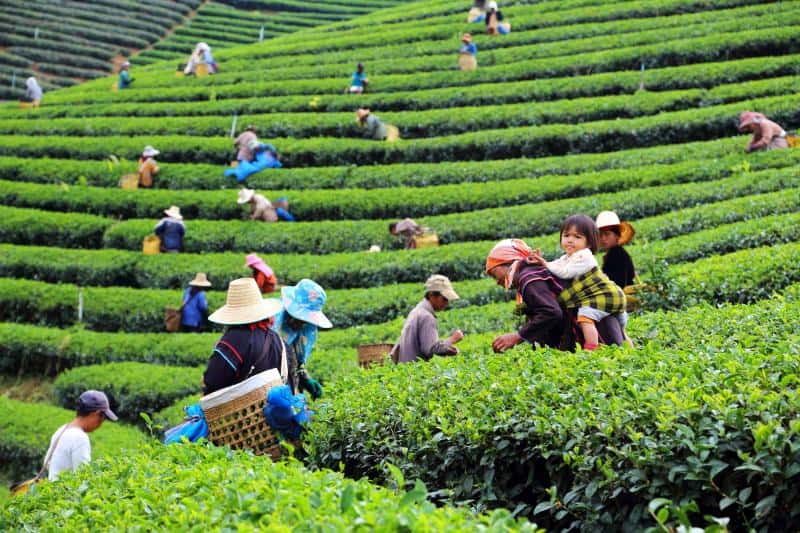
Thailand has swiftly and effectively constructed its brand on the global coffee trade, climbing up to the third-largest coffee producer in Asia. First introduced in the 1970s, the natural terrain was ideal for the crop, which leads to the creation of incredibly unique blends only found in this region.
Stages of Production
Over the years, many methods have been tweaked and altered. But essentially, there are ten steps of production from ground to cup.
Planting Coffee Seeds
Any coffee bean that hasn’t been dried or roasted is an eligible candidate.
They’re planted in temporary nurseries on large beds where sunlight exposure can be easily regulated. When strong enough, they’re transported and permanently planted in moist soil. This is always done during the rainy seasons.
Cherry Harvesting

Cherry harvesting is a patient process. Freshly planted trees take between 3 to 4 years to bloom and bear fruit, which is the cherries. They start green and turn dark red when ripe. Although grown in the mountains, the cherries ripen faster at lower altitudes. Cherries are usually picked by hand during multiple cycles.
After cherries are picked, it’s time for.
Processing Coffee
Processing is done immediately to prevent the cherries from spoiling. There are two ways to process coffee beans, the wet and dry methods.
The dry method is an old-school technique developed in countries without easily accessible freshwater. Cherries are spread out onto massive surfaces and dried by the sun.
They’re churned and flipped throughout the day and covered at night to shield from the elements. Depending on the weather, this process can take weeks.
The wet method has become the modern choice for coffee producers. This process removes the skin and pulp from the bean by passing them through machines.
The beans are dried with only a thin layer of skin. Then, the beans pass through water chambers that separate them by weight. The ripe cherries sink to the bottom while the others float to the top. They are then churned in massive drums that divide the beans by size.
Then they’re transferred into massive water-filled tanks to ferment, which takes between 12 to 48 hours depending on the environment. Fermentation causes the last remaining bits of skin to dissolve.
Since most coffee producers use the wet method, the next step is drying.
Drying The Coffee Beans
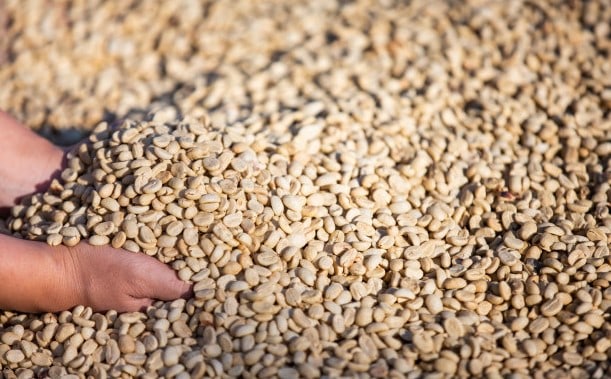
They are done by either spreading them out under the sun or churned inside giant industrial dryers. They will do this drying process until they only retain 11 percent moisture.
Milling Coffee
- Milling is broken into three steps: hulling, polishing, and grading.
- Hulling is the removal of any leftover skin missed while processing.
- Polishing is an optional step that removes any discolored blotches remaining on the beans from the skin. Many producers skip this step because there is almost no difference between “polished” and “unpolished” beans.
- Grading is the sorting of the final batch. Typically using airflow, the beans are sorted by size, shape and further examined for defects and cosmetic blemishes. The final examination is typically done by hand.
Exporting The Goods
The freshly milled beans, which are referred to as “green beans” due to their color, are carefully stored away and prepped for shipment.
After roasters receive the shipment, it’s time for the fun part, taste testing.
Coffee Taste Test
The initial taster, known as a cupper, first examines the visual appeal. A small portion of beans are then roasted, ground, and brewed to examine their flavors and aromas, determining the quality. A cupper will also decide which batches are suitable for blending.
After the beans make the cut, it’s finally time for roasting!
Roasting The Coffee
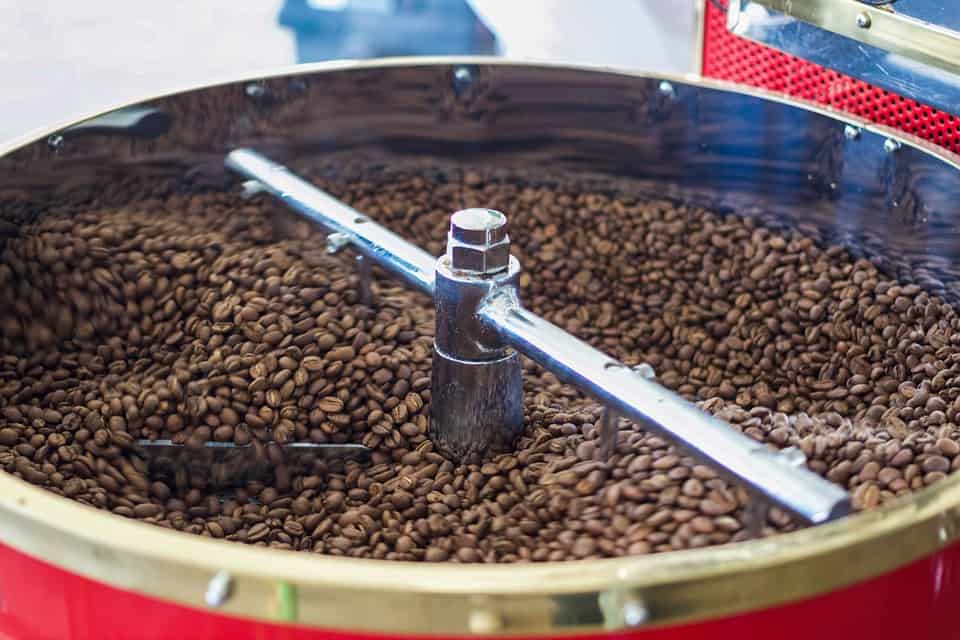
This is when the beans are loaded into an oven and roasted to the desired profile. Roasting profiles range from light to dark and determines the beans’ “personality.” When internal temperatures reach 400 degrees(F), they experience the “first crack.”
When beans crack, the oils and aromas escape providing us with the smell and taste we’re all too familiar with.
We go over the first and second crack in detail in our article, Why Are Coffee Beans Oily – Here are All The Reasons!
Light roasts offer fruity and vibrant tones due to their high acidity while distributing most of their origin flavor due to the short roasting duration.
Medium roasts provide the most balanced notes of any other roast. They present a dark yet sweet flavor profile comparable to chocolate and berries.
Dark roasts are the harshest of the bunch. They possess bold, sometimes bitter flavors. Low-quality beans are often dark roasted to conceal the diminished oils.
If the producer isn’t selling whole beans, the next step is (9.) Grinding. This step goes without explanation. It also gives the seller the chance to make espresso grounds, which is essentially extra finely ground coffee.
The final step is to simply choose a brewing method and enjoy!
How Often Can Coffee Be Harvested?

While coffee trees can be planted year-round, there is usually only one harvesting season which lasts about three months.
Columbia and Kenya are exceptions as they harvest fly crops, which are secondary crops of lower quality, farmed in different schedules during summer months.
The season depends on which side of the equator you’re on. Countries north of the equator harvest in September through March, while countries south of the equator harvest in April through August.
Harvesting is challenging work that requires multiple pass-throughs during harvest months. If cherries are harvested too early, their high acidity could compromise the yield.
After reaching full maturity, a single coffee tree can produce up to one pound of coffee per year.
With tedious picking and physically demanding terrain, harvesting coffee is no simple feat.
The Picking Process
As stated throughout this article, picking coffee cherries is a very labor-intensive activity.
There are two main methods used for picking: strip and selective picking, which are pretty much exactly what they sound like.
Selective picking is when ripe cherries are picked individually from a tree while unripe cherries are left for the next cycle.
The demanding landscapes make it impossible for machines to maneuver in, so they are almost always handpicked, which is very time-consuming.
During the harvest season, the cherries ripen at different paces. So every 8 to 10 days, the pickers venture out to nab the newly ripened cherries.
A seasoned harvester can gather as much as 200 pounds of cherries per day, roughly translating to about 50 to 60 pounds of raw coffee! Mix that with muggy weather and mountainous terrains, and no wonder coffee costs so much.
When a picker gathers 100 pounds of fruit, only 20 percent of that is coffee, and only 20 percent of that makes the cut to processing. A truly tedious venture. Workers are often paid based on the weight of their yield.
Strip picking consists of stripping whole tree branches of fruit all at once. This process typically uses machines.
Brazil is a great example. Brazilian farmland can be relatively flat, allowing machines to bust out the hefty workload and easily strip the trees down.
Wrapping Up
The process of getting coffee to your cup is a lenthy one. After researching this process I really appriate the globla coffee trade and everyone envoived.
For another good article, check out our guide, Easy Ways to Level Up Your Home Barista Game!
